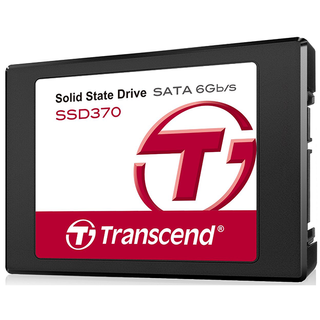Transcend SSD370 Review
Transcend's premium SSD offering consists of a custom Silicon Motion controller that enables encryption and DEVSLP, but questionable flash makes it a poor choice.
Why you can trust Tom's Hardware
Technical Specifications
Transcend released the SSD370 in six capacity sizes that range from 32GB to 1TB. The two smallest sizes were left off the chart. They are intended for other roles, such as digital signage. We were surprised to see Transcend use the same model number for the smallest-capacity products.
MORE: Best SSDs For The Money
MORE: Latest Storage News
MORE: Storage in the Forums
Transcend didn't make it easy to find all of the product specifications. We tracked down a few documents and pieced together the above information. If you research the SSD370 model, you will quickly notice two different designs. Transcend made the SSD370 that we're testing today with a plastic case, but the company also offers a SSD370 model with an aluminum case. To spot the aluminum model while you're shopping, you need to look for the specific model number — TS512GSSD370 refers to the 512GB model we're testing today. Add an "S" on the end — TS512GSSD37S — and you have the silver brushed-aluminum model.
Controlling the drive is a Transcend TS6500 processor based on Silicon Motion's SM2246EN controller. Transcend added DEVSLP, a feature not always found on SSDs using the SM2246EN.
The NAND flash used in it is not as cut and dry. All but one unit shipped for review previously used genuine Micron Grade A flash. One reviewer in Russia received a drive with SpecTek flash, as we did on our 512GB sample. The SpecTek -AL flash is the Micron subsidiary's best NAND flash part, but it's not considered the same 20-nm 128-gigabit Tier 1 Grade A flash that Micron sells to customers or uses in-house. SpecTek sells Micron flash that often doesn't pass full performance or quality-control tests. At one time, OCZ Technology (prior to the Toshiba acquisition) shipped products with SpecTek flash, and other SSD vendors spoke up:
"When we took the cover off of this third, direct from OCZ SSD, we found a 'S' stamped over Micron logo on all the flash devices (see the image to the left). This indicates the device is 'off spec' product because it failed some parameter of Micron's full performance and/or quality specification testing. 'Off spec' memory is typically used in low-level applications such as toys, offering considerable cost savings over Tier 1 level to an SSD manufacturer." - Grant Dahlke, formally of Other World Computing (OWC)
The SpecTek 20-nm 128-gigabit part number we found in our SSD370 512GB sample is SpecTek's highest-grade offering. We still don't like seeing this flash used in products like SSDs where reliability trumps low cost. . Most users will not have an issue with it, but we were told by engineers in the industry that any part using this flash will have higher return merchandise authorization (RMA) rates than parts using Tier 1 Grade A flash. One SSD retailer we spoke with noted an increase in RMAs on products using less than Grade A flash. The difference is 1 in 300 products returned with Tier 1 Grade A flash, compared with 9 in 300 products returned using the lower-grade flash.
Our 256GB SSD370 sample did ship with genuine Micron 20-nm MLC flash. Given that nearly all of the reviewers have received Micron flash but products shipping in the wild are mixed, we can't say what flash you may receive in your retail product. Transcend never discloses which type of flash is guaranteed. This topic has come up with other low-cost SSDs from other manufactures in years past. The backlash from end users has never been positive, even when those users never experienced a single problem.
Current page: Technical Specifications
Prev Page Introduction Next Page Pricing, Warranty and AccessoriesStay on the Cutting Edge
Join the experts who read Tom's Hardware for the inside track on enthusiast PC tech news — and have for over 25 years. We'll send breaking news and in-depth reviews of CPUs, GPUs, AI, maker hardware and more straight to your inbox.
-
synphul Good info to have. More problematic than the confusing product model numbers correlating to plastic vs aluminum bodies I think are the differences in the internals. I'm not sure how this is considered proper practice since changing the controller and the nand flash is basically selling a different quality drive even if the specs are loosely similar. Makes people like myself wonder how they can get away with this and yet nvidia had to answer to a class action lawsuit over the layout of their vram when in fact they did have the full 4gb of vram on the card. It just reeks of bait and switch. Especially when as mentioned reviewers are often given cherry picked units that don't necessarily reflect the common resale market most consumers will be met with.Reply
It would be nice to see manufacturers give review sites a voucher instead, rather than sending a unit directly for testing. Good for 1 purchase of the part slated for review from the retailer of their choice to ensure it's random and more indicative of the lottery a consumer would face. That is so long as they were confident that a random off the shelf unit would fairly represent their products rather than one specially set aside for review.
It may not seem like such a big deal but with the guts swapped out for lower cost and potentially lower quality alternatives that's an issue. I wouldn't be happy purchasing a top tier tool set only to find out it included a number of budget store brand replacements in lieu of what I paid for just because it's 'basically' the same. In just about any other scenario this would create great backlash. Why is it just accepted as common practice in the form of ssd drives? Not that I'm sue happy or think lawsuits are the solution in an attempt for gains but some sort of reassurance that the customer is getting what they're told they're buying rather than sold on a song and given something entirely different. -
crabdog +1 for this review. It's nice to see someone report the truth and their real concerns without sugar coating.Reply -
Bannereus good to see that not every product is top of the line, gives meaning to those that earn top recommendationsReply
but please fix Section 5. "Test PERIMETERS ..." -
Wisecracker ""Paralysis by Over-Analysis""Reply
(leads to ridiculous conclusions)
The real-world tests show there is generally one percent or less difference between the drives tested, so the bottom line is ...
buy whatever SSD (with a 3-yr warranty) that is on sale.
-
fudgecakes99 i bought one for 160 from amazon 512gb's, on sale. Have yet to boot it as skylate 6700k has yet to be released in america, from the charts i dont' see a major difference save about 70-90 mb's write difference, as someone moving up from a 5200rpm hdd i expect great things.Reply -
CRamseyer Kingston's V300 went from the top ten selling SSDs on Amazon to off of the list when the info was picked up by review site news teams.Reply -
shrapnel_indie Disappointing to see price-point win over quality... yet again.Reply
Manufacturers have been sending cherry-picked "review" units of products for decades, nothing new there... sadly it's to get the best reviews possible while hoping consumers won't be able to tell the difference in the actual product.
The "product specification may change" disclaimer has been around for a while. Sometimes it is used due to certain components going away, becoming too expensive (for the price point the bean counters and marketing decide on), or (less seen as it means they care about the product and reputation) quality goes south. Sadly it is more often abused just to make sure tier-1/top tier executives get their (large as they can get away with) bonus checks. -
kalmquist The Crucial BX100 line uses the same controller as the Transcend SSD370. I've heard no reports of Crucial using cut-rate NAND, and I wouldn't be expect them to since Cruical (aka Micron) makes its own NAND. Recently, prices have been lower for the BX100 than the SSD370. It seems like the BX100 would be a better option for anyone who might consider an SSD370.Reply
-
Dark Falz I got a 256 and 512 about a year ago, main concern was price. I wanted the MX100 instead but couldn't find any in stock at the time. Have served me fine but definitely weren't worth the money. Has received no Firwmare updates/improvements (which I suppose is not always necessarily a bad thing, look at the 840). The plastic housing doesn't bother me except for the fact there's no temperature sensor in the SMART data, so I can't tell how warm it gets. Will probably upgrade to a 1 or 2 TB when they become more affordable and put this on my laptop instead. It performs much like any other SSD but disappointing to see it fare so badly in the theoreticals (when I bought it, there were not many reviews).Reply


